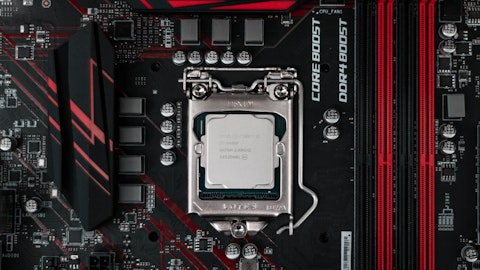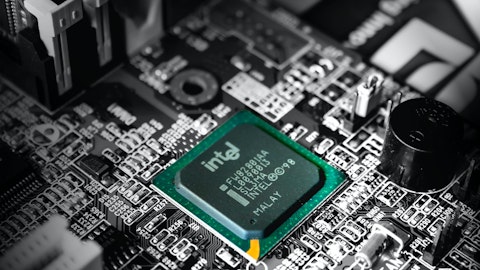NXP Semiconductors N.V. (NASDAQ:NXPI) Q4 2022 Earnings Call Transcript January 31, 2023
Operator: Hello. Thank you for standing by, and welcome to the NXP Fourth Quarter 2022 Earnings Conference Call. At this time, all participants are in a listen-only mode. After the prepared remarks’, we will conduct the question-and-answer session and instructions will be given at that time. I would now like to hand the conference over to your speaker today, Jeff Palmer, Senior Vice President of Investor Relations. Please go ahead.
Jeff Palmer: Thank you, Michelle, and good morning, everyone. Welcome to NXP’s fourth quarter and full year 2022 Earnings Call. With me on the call today is Kurt Sievers, NXP’s President and CEO; and Bill Betz, our CFO. The call today is being recorded and will be available for replay from our corporate website. Today’s call will include forward-looking statements that involve risks and uncertainties that could cause NXP’s results to differ materially from management’s current expectations. These risks and uncertainties include, but are not limited to, statements regarding the continued impact of the COVID-19 pandemic on our business, the macroeconomic impact on the specific end markets in which we operate, the sale of new and existing products and our expectations for the financial results for the first quarter of 2023.
Please be reminded that NXP undertakes no obligation to revise or update publicly any forward-looking statements. For a full disclosure on forward-looking statements, please refer to our press release. Additionally, we will refer to certain non-GAAP financial measures, which are driven primarily by discrete events that management does not consider to be directly related to NXP’s underlying core operating performance. Pursuant to Regulation G, NXP has provided reconciliations of the non-GAAP financial measures to the most directly comparable GAAP measures in our fourth quarter 2022 earnings press release, which will be furnished to the SEC on Form 8-K and available from NXP’s website in the Investor Relations section at nxp.com. Now I’d like to turn the call over to Kurt.
Kurt Sievers: Thanks, Jeff, and good morning, everyone. We really appreciate you joining our call this morning. I will review both our quarter four and our full year 2022 performance, and then I will discuss our guidance for quarter one. Beginning with quarter four, our revenue was $12 million better than the midpoint of our guidance with the trends in the mobile and industrial and IoT markets performing better than our expectations, while Automotive was in line and Communication Infrastructure below our expectations. Taken together, NXP delivered quarter four revenue of $3.31 billion, an increase of 9% year-on-year while maintaining channel inventory at a 1.6 months level, well below our long-term target. Non-GAAP operating margin in quarter four was a strong 36.5%, 160 basis points better than the year ago period and about 50 basis points above the midpoint of our guidance.
Year-on-year outperformance was a result of good fall through on the higher revenue, better gross margin due to higher factory utilization and disciplined expense management. Now let me turn to the full year performance. Revenue was a record $13.21 billion, an increase of 19% year-on-year. When passing the revenue growth, approximately 14% was due to higher pricing – and was due to a combination of volume and mix. And here, as a reminder, we have executed a consistent pricing policy to pass along the inflationary increases of our input costs while not patting our gross margin. Throughout 2022, we consistently found ourselves in a situation where robust demand across automotive and core industrial markets, outstripped available supply even as production levels, both internally and from our supplier partners improved through the year.
And now we do see a continuation of input cost inflation in 2023, however, not at the same pace and level we experienced in 2022. The full year non-GAAP operating margin was solid 36.3%, a 340 basis point improvement versus the year ago period as a result of higher revenue, improved factory loadings and positive operating leverage. Now let me move to the specific trends in our focus end markets. First, Automotive. Full year revenue was $6.88 billion, up 25% year-on-year, a reflection of higher pricing, our strong company-specific product drivers and accelerated content increases, thanks to the secular growth in sales of xEV vehicles and prioritization by OEMs of premium class vehicles in a limited supply environment. For the fourth quarter, Automotive revenue was $1.81 billion, up 17% versus the year ago period and in line with our guidance.
Now moving to Industrial and IoT. Full year revenue was $2.71 billion, up 13% year-on-year, primarily due to higher pricing and the strong competitive positioning of our solution offering comprising industrial processes and about cash connectivity and security. For the fourth quarter, Industrial and IoT revenue was $605 billion, down 8% versus the year ago period, so better than our guidance. Mobile. Full year revenue was $1.61 billion, up 14% year-on-year, primarily due to higher pricing and continued traction of our secure mobile wallet. For quarter four, Mobile revenue was $408 million, up 9% versus the year ago period and better than our guidance. Lastly, Communication Infrastructure and Other. Full year revenue was $2 billion, up 15% year-on-year.
The year-on-year growth was due to higher pricing and a combination of sales growth of network processors, RFID tech solutions, secured transit and access products and RF power products for the cellular base station markets. For quarter four, Communication Infrastructure and Other revenue was $494 million, up 8% year-on-year and below our guidance. Now as discussed earlier, I also would like to provide you a progress update on our accelerated growth drivers. At our Analyst Day in November ’21, we highlighted our expectation to grow total company revenue to approximately $15 billion in 2024, coming from $11 billion in 2021 within a compound annual growth range of 8% to 12% over that period. Embedded within this outlook, we highlighted six company-specific revenue drivers across all our served end markets, which we anticipated to grow in aggregates to about $6 billion in ’24 from a $3 billion level in ’21, representing about a 25% 3 year compound annual growth range.
Additionally, we shared with you that our high relative market share for business would grow to $9 billion in ’24 from $8 billion in ’21, reflecting about a 5% 3 year compound annual growth range. Overall, we are confident to achieve the anticipated growth rates for both our accelerated growth drivers as well as our high relative market share core business. Moving to the segments. Within Automotive, the accelerated growth drivers are 77 gigahertz radar, electrification and the S32 domain and solar processes, all of which are tracking ahead of plan. According to market research company, Yole, NXP is confirmed as the clear number one revenue market leader in automotive radar solutions, as well as individually in radar RF transceivers and radar processes.
Furthermore, we just announced the industry’s first 28-nanometer RF CMOS radar one-chip IC family for the next-generation ADAS and autonomous driving systems. Turning to our efforts in electrification. Our sales, including battery management solutions, inverter control and other xEV control processes has doubled year-on-year and achieved record custom design wins. Finally, within Automotive, the customer enthusiasm for this S32 domain and sonar processor family, enabling the software-defined vehicle, are far in excess of our expectations. This includes the awards by a major automotive OEM, which selected the S32 family of automotive processes and microcontrollers to be used across its fleet of future vehicles beginning mid-decade. Moving to Industrial and IoT.
We are in line with our expected growth range of about 25% 3 year CAGR for our accelerated growth drivers. Both our crossover and i.MX application processor families grew nearly 50% year-on-year in 2022. However, we did see a deceleration in revenue in the consumer IoT portion of the end markets during the second half of 2022. Finally, we announced our new MCX microcontroller portfolio that is scalable, optimized foundation for energy-efficient industrial and IoT edge applications, addressing the heavy real-time workloads for the next wave of innovation. In addition, we recently announced our new analog front-end family for high-precision data acquisition and condition monitoring systems for factory automation. Moving to Mobile. We are below our expected revenue growth range for the accelerated growth driver of ultra-wideband due to the well-documented weakness in the Android handset market, which is the focused mobile market for our ultra-wideband solutions.

Photo by L N on Unsplash
However, for ultra-widebands, the ecosystem build-out and design win activity and traction in both Mobile and Auto are going well. And we believe as the Android market rebounds, awarded design wins will result in the expected revenue growth for ultra-widebands. Lastly, within Communications and Infrastructure, we are in line with our expected revenue growth range for RF power amplifiers. The industry transition to gallium nitride from LDMOS technology has occurred faster than expected. The revenue for our gallium nitride-based solutions has doubled year-on-year and demand continues to outstrip our increasing supply capability. In review, 2022 was a very good year for NXP, with strong execution resulting in record revenue, solid profit growth and a healthy free cash flow generation.
Additionally, we experienced unprecedented year-on-year design win traction across the entire portfolio. Now let me turn to our expectations for quarter one, 2023. We are guiding quarter one revenue to $3 billion, down about 4% versus the first quarter of ’22. From a sequential perspective, this represents a deceleration of about 9% at the midpoint versus the prior quarter. At the midpoint, we anticipate the following trends in our business. Automotive is expected to be up in the mid-teens percent range versus quarter one ’22 and flat versus quarter four ’22. Industrial and IoT is expected to be down in the low 30% range year-on-year and down in the low 20% range versus quarter four ’22. Mobile is expected to be down about in the mid-40% range, both on a year-on-year and sequential basis.
Finally, Communication Infrastructure and Other is expected to be about flat, both on a year-on-year and sequentially. In summary, as we head into 2023, our Automotive and Core Industrial businesses remain supply constraints in select areas. Within Automotive, the increase of global production levels and the secular adoption of xEV are tailwinds to continued content increases. In Industrial and IoT, we expect relative strength in the core industrial submarkets as our products enable critical infrastructure and companies to be more efficient. However, the Consumer IoT and the Mobile segment will continue to be dependent on a cyclical rebound. And lastly, in Communications Infrastructure, we expect our supply capability to improve against pent-up demand, specifically in our RFID packing solutions, secure access products and e-government identification.
Within the 5G base station markets, growth in ’23 will be dependent on the build-out, especially in India. At the same time, we do believe from an external macro perspective, the general demand environment is offering much higher levels of uncertainty than last year. And in the very short term, we are expecting a dip in China due to the spike in infection rates following the policy shift relating to COVID. Additionally, we expect continued cyclical weakness in demand for consumer-oriented products and a potential correction of customer inventory. In this more uncertain demand environment, we will focus on prudently managing what is in our control. And especially while we have plenty of orders, we will continue to very vigilantly manage general inventory to a 1.6 months level, which is about a month’s below our long-term target, equaling approximately $500 million of revenue.
We intend to maintain that 1.6 months channel inventory in the first quarter, while we are well positioned with our on-hand inventory to increase channel inventory, if and when demand in China evolves. So far, quarter-to-date, our distribution sales through in China is off to a slow start as is incorporated in our guidance. Over the midterm, we are cautiously optimistic given customer engagement levels, design win momentum in our strategic focus areas and a potential rebound in China. And now I would like to pass the call to you, Bill, for a review of our financial performance.
Bill Betz: Thank you, Kurt, and good morning to everyone on today’s call. As Kurt has already covered the drivers of revenue during Q4 and provided our revenue outlook for Q1, I will move to the financial highlights. Overall, our Q4 financial performance was very good. Revenue was slightly above the midpoint of our guidance range and both non-GAAP gross profit and non-GAAP operating profit were above the midpoint of our guidance. I will first provide full year highlights and then move to the Q4 results. Full year revenue for 2022 was $13.21 billion, up 19% year-on-year. We generated $7.64 billion in non-GAAP gross profit and reported a non-GAAP gross margin of 57.9%, up 180 basis points year-on-year as a result of higher internal factory utilization and fall-through on higher revenue, which is at the high end of our long-term financial model.
Total non-GAAP operating expenses were $2.86 billion or 21.6% of revenue, below our long-term financial model. Total non-GAAP operating profit was $4.79 billion, up 32% year-on-year. This reflects a non-GAAP operating margin of 36.3%, up 340 basis points year-on-year and above our long-term financial model. Non-GAAP interest expense was $386 million. Cash taxes for ongoing operations were $558 million, non-controlling interest of $46 million and stock-based compensation, which is not included in our non-GAAP earnings, was $364 million. Full year cash flow highlights include $3.9 billion in cash flow from operations and $1.06 billion in net CapEx investments or 8% of revenue, resulting in $2.83 billion of non-GAAP free cash flow, up 23% year-on-year or a healthy 21% of revenue.
During 2022, we repurchased 8.33 million shares for $1.43 billion and paid cash dividends of $815 million or 21% of cash flow from operations. In total, we returned $2.2 billion to our owners, which was 79% of the total non-GAAP free cash flow generated during the year. Now moving to the details of Q4. Total revenue was $3.31 billion, up 9% year-on-year, in line with the midpoint of our guidance range. We generated $1.92 billion in non-GAAP gross profit and reported a non-GAAP gross margin of 58%, up 70 basis points year-on-year and consistent with the midpoint of our guidance range. Total non-GAAP operating expenses were $713 million or 21.5% of revenue, which is up $32 million year-on-year and down $17 million from Q3, slightly favorable to the midpoint of our guidance.
From a total operating profit perspective, non-GAAP operating profit was $1.21 billion, and non-GAAP operating margin was 36.5%, up 160 basis points year-on-year, above the midpoint of our guidance range, reflecting solid fall-through in operating leverage on the increased revenue level. Non-GAAP interest expense was $95 million, with cash taxes for ongoing operations of $126 million and non-controlling interest was $12 million. Stock-based compensation, which is not included in our non-GAAP earnings was $97 million. Now I would like to turn to the changes in our cash and debt. Our total debt at the end of Q4 was $11.17 billion, essentially flat sequentially. Our ending cash position was $3.85 billion, up $86 million sequentially due to the cumulative effect of capital returns, CapEx investments and cash generation during Q4.
The resulting net debt was $7.32 billion, and we exited the quarter with a trailing 12 month adjusted EBITDA of $5.47 billion. Our ratio of net debt to trailing 12 month adjusted EBITDA at the end of Q4 was 1.3 times, and our 12 month adjusted EBITDA interest coverage was 14.9 times. Cash flow generation of the business continues to be healthy and our balance sheet continues to be very strong. During Q4, we paid $221 million in cash dividends and repurchased $475 million of our shares. Additionally, the NXP Board of Directors has approved a 20% increase in our quarterly cash dividend, bringing the quarterly cash dividend to approximately $1 per share. These actions are all aligned with our capital allocation strategy. Turning to working capital metrics.
Days of inventory was 116 days, an increase of 17 days sequentially and distribution channel inventory was 1.6 months. As we mentioned on our last quarter’s call, given the uncertain demand environment, we made the intentional choice to limit the months of inventory in the channel, while keeping inventory on our balance sheet to enable greater flexibility to redirect product as needed. Furthermore, given our manufacturing cycle times, combined with the uncertain demand environment in the first half of 2023, we will continue with this approach in Q1, and we expect DIO to increase in the quarter. Days receivable were 26 days, down one day sequentially and days payable were 105 days, an increase of 9 days versus the prior quarter due to the timing of material.
Taken together, our cash conversion cycle was 37 days, an increase of 7 days versus the prior quarter. Cash flow from operations was $1.08 billion and net CapEx was $233 million, resulting in non-GAAP free cash flow of $843 million or approximately 25% of our revenue. Turning now to our expectations for the first quarter. As Kurt mentioned, we anticipate Q1 revenue to be $3 billion, plus or minus about $100 million. At the midpoint, this is down 4% year-on-year and down 9% sequentially. We expect non-GAAP gross margin to be about 58% plus or minus 50 basis points, driven by favorable mix, offset by the lower revenue. Operating expenses are expected to be about $710 million, plus or minus about $10 million. Taken together, we see non-GAAP operating margin to be 34.3% at the midpoint.
We estimate non-GAAP financial expense to be about $77 million. We anticipate the non-GAAP tax rate to be 16.5% of profit before tax. Non-controlling interest and other will be about $10 million. For Q1, we suggest for modeling purposes you use an average share count of 261.4 million shares. Taken together, at the midpoint, this implies a non-GAAP earnings per share of $3.01. For full year 2023 modeling purposes, we suggest for a non-GAAP tax rate you use a range between 16% to 17%. This is lower than our previously anticipated effective cash tax rate of 18% and is based on current tax legislation. For stock-based compensation, we suggest you use $410 million, no change from the model. For non-controlling interest, we suggest you use $30 million to $40 million lower than 2022 and for capital expenditures, we expect to invest approximately 8% of our revenue.
In closing, looking ahead into 2023, I’d like to highlight a few focus areas for NXP. First, we plan to execute and drive our six company-specific accelerated growth drivers. Second, we will manage our internal and channel inventory thoughtfully based on market conditions. Thirdly, we will continue to be disciplined with our operating expenses, while protecting our long-term R&D investments. Taken together, we plan to operate within our long-term financial model ranges in what is a dynamic macro environment. I’d like to now turn it back to the operator for questions. Thank you.
Q – Christopher Caso: Yes, thank you. Good morning. I guess to start, Kurt, perhaps you could speak to your comments on managing the channel inventory. And of course, one of the concerns investors naturally have is the worry that customers order more than they need given the constraints at the present over the last year and then potentially you overship that. Can you speak to how you’re ensuring that what you’re shipping to customers now is actually going to real demand rather than inventory? And I guess that’s particularly as some of the foundry capacity loosens up, gives you a little – a little more access to wafer supply?
See also 10 Most Undervalued Tech Stocks To Buy and 12 Most Undervalued Travel Stocks To Buy .
Q&A Session
Follow Nxp Semiconductors N.v. (NASDAQ:NXPI)
Follow Nxp Semiconductors N.v. (NASDAQ:NXPI)
Kurt Sievers: Yeah. Thanks, Chris, and thanks for taking the first question. Yes, the very, very vigilant management of the channel inventory is a very deliberate choice Bill and I took. And we do this while we have more than enough orders at hand to actually ship, say, another $500 million in the quarter into the channel and still hitting our target of 2.4 or 2.5 months of inventory. But we take the choice because we specifically now in China see a weakness. Actually, we think the weakness in China, which for us is almost entirely distribution. We see that connected to the change of corporate policy, which they took in early or first half of December and the spike of infection rates following that. And we just want to be responsible through this period of weakness in China, but watching the situation very carefully.
So as soon as we would see signs of consistent rebound in China, we have both the orders, but also the product at hand to actually fill back the channel. So it’s kind of our choice, which we took here, and I have to say this is across all segments. So that weakness, which we see in China, is not really segment specific, it is distribution specific across the board related to this policy change and infection spike in China. Maybe important to highlight that at the very same time, we are seeing across the board very strong trends in our direct customers. So it’s – we have a very diverging – last quarter, we spoke about the dichotomy, very diverging picture now that from a segment perspective, Auto and Core Industrial remain strong. But now we have an additional effect here that we see this short-term weakness in China, which we try to be prudent about with the choice of the channel inventory stable.
Christopher Caso: Got it. Thank you. As a follow-up, if I could pivot to Auto. And question is what’s a reasonable expectation for Auto revenue for the year, if not quantitatively, at least qualitatively? And it was flat last quarter, you’re managing to be flat again. Is it – should it stay flat from here? Are you trying to get additional capacity in the process nodes needed for Auto. So that quarterly revenue would at one point rise and catch up on that backlog?
Kurt Sievers: Yes. Let me give you some color on Q4, Q1 and then directionally for the year. Indeed, Q4 was flat from a quarter-on-quarter perspective, by the way, nicely up year-on-year really because of supply constraints. I mean we just did – we couldn’t ship more because we didn’t have more products in Q4. In Q1, it’s a bit more of a mixed bag. We are getting more products. But at the same time, we – Automotive in China distribution falls under what I said earlier. So we have a bit of a decline when you think about Automotive distribution in China, while the rest is actually going up at the same time. In the mix, it turns out to be then flat quarter-on-quarter and again, nicely up from a year-on-year perspective. Maybe more importantly, for the full year, yes, we are optimistic, Chris.
We see, according to IHS, a far increased to about 85 million, so I think 82 million cars last year, going to 85 million this coming year, which is 3.5 or so percent increase and more importantly, definitely a continued increase of xEV, electric vehicle penetration. Again, according to IHS, I think going to 35% of the total car production having hybrid or fully electric drivetrains, which is significant and continues to be a significant boost from a content perspective for us. At the same time, we are gradually as through the last quarters, getting access to more supply. I dare to say from today’s perspective that probably through the end of the calendar year ’23, I hope we have most of the shortages behind us. I mean that will never be totally complete, but I think we are getting closer to a better balance towards the end of the year.





